查尔斯狄更斯简介中英文版
- 格式:pptx
- 大小:1.24 MB
- 文档页数:17
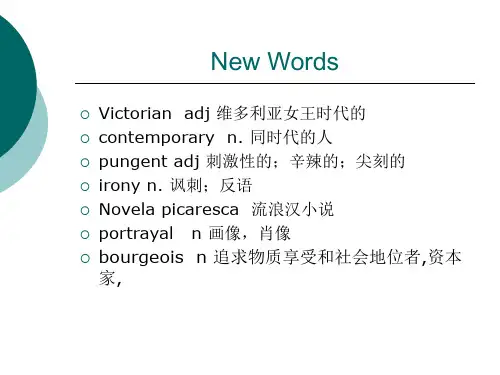
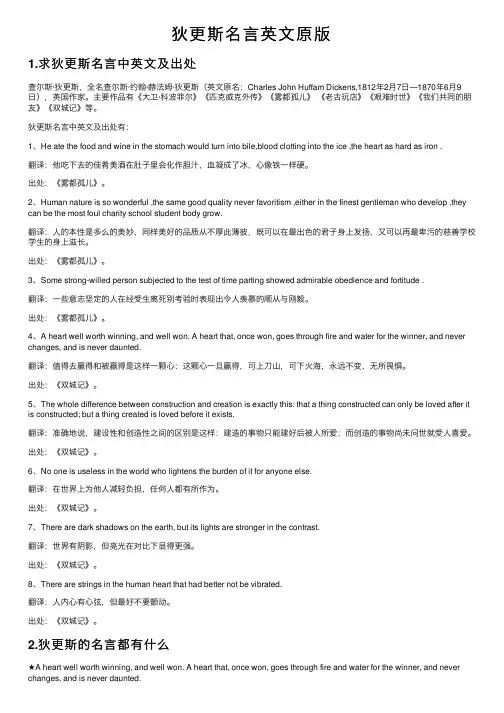
狄更斯名⾔英⽂原版1.求狄更斯名⾔中英⽂及出处查尔斯·狄更斯,全名查尔斯·约翰·赫法姆·狄更斯(英⽂原名:Charles John Huffam Dickens,1812年2⽉7⽇—1870年6⽉9⽇),英国作家。
主要作品有《⼤卫·科波菲尔》《匹克威克外传》《雾都孤⼉》《⽼古玩店》《艰难时世》《我们共同的朋友》《双城记》等。
狄更斯名⾔中英⽂及出处有:1、He ate the food and wine in the stomach would turn into bile,blood clotting into the ice ,the heart as hard as iron .翻译:他吃下去的佳肴美酒在肚⼦⾥会化作胆汁,⾎凝成了冰,⼼像铁⼀样硬。
出处:《雾都孤⼉》。
2、Human nature is so wonderful ,the same good quality never favoritism ,either in the finest gentleman who develop ,they can be the most foul charity school student body grow.翻译:⼈的本性是多么的美妙,同样美好的品质从不厚此薄彼,既可以在最出⾊的君⼦⾝上发扬,⼜可以再最卑污的慈善学校学⽣的⾝上滋长。
出处:《雾都孤⼉》。
3、Some strong-willed person subjected to the test of time parting showed admirable obedience and fortitude .翻译:⼀些意志坚定的⼈在经受⽣离死别考验时表现出令⼈羡慕的顺从与刚毅。
出处:《雾都孤⼉》。
4、A heart well worth winning, and well won. A heart that, once won, goes through fire and water for the winner, and never changes, and is never daunted.翻译:值得去赢得和被赢得是这样⼀颗⼼:这颗⼼⼀旦赢得,可上⼑⼭,可下⽕海,永远不变,⽆所畏惧。
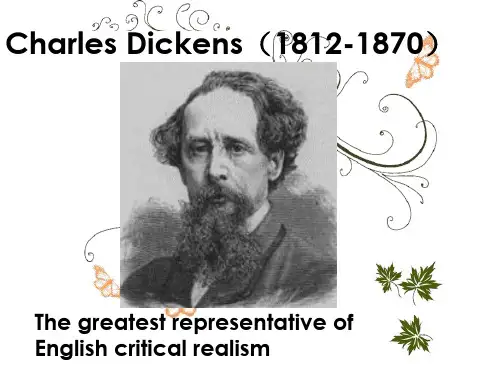
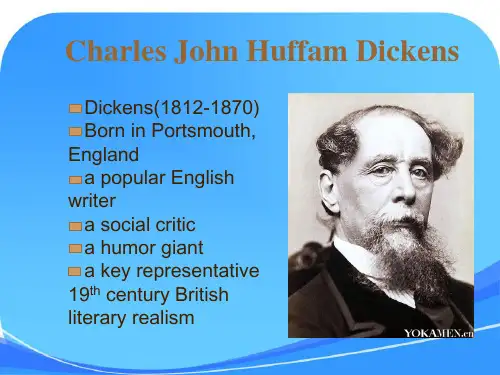

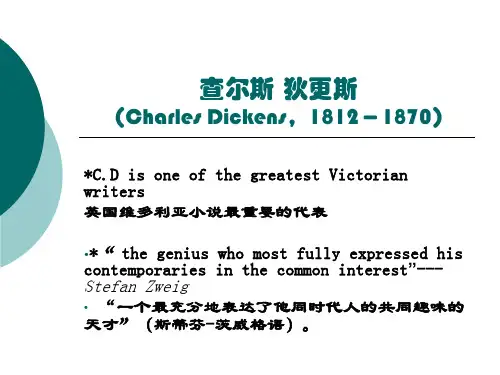
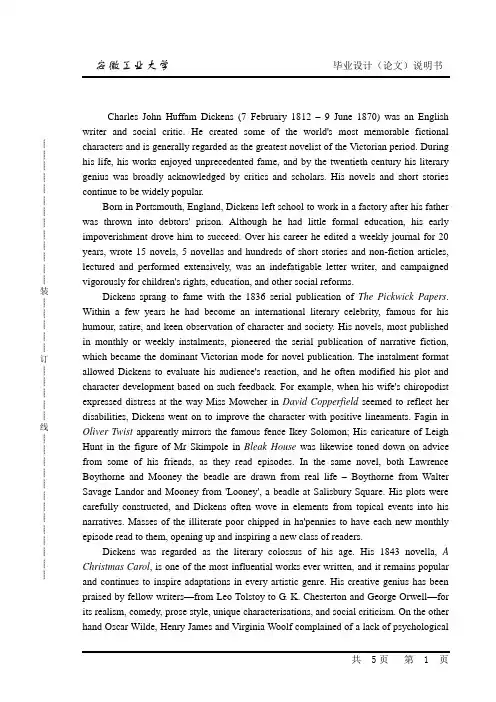
┊┊┊┊┊┊┊┊┊┊┊┊┊装┊┊┊┊┊订┊┊┊┊┊线┊┊┊┊┊┊┊┊┊┊┊┊┊Charles John Huffam Dickens (7 February 1812 –9 June 1870) was an English writer and social critic. He created some of the world's most memorable fictional characters and is generally regarded as the greatest novelist of the Victorian period. During his life, his works enjoyed unprecedented fame, and by the twentieth century his literary genius was broadly acknowledged by critics and scholars. His novels and short stories continue to be widely popular.Born in Portsmouth, England, Dickens left school to work in a factory after his father was thrown into debtors' prison. Although he had little formal education, his early impoverishment drove him to succeed. Over his career he edited a weekly journal for 20 years, wrote 15 novels, 5 novellas and hundreds of short stories and non-fiction articles, lectured and performed extensively, was an indefatigable letter writer, and campaigned vigorously for children's rights, education, and other social reforms.Dickens sprang to fame with the 1836 serial publication of The Pickwick Papers. Within a few years he had become an international literary celebrity, famous for his humour, satire, and keen observation of character and society. His novels, most published in monthly or weekly instalments, pioneered the serial publication of narrative fiction, which became the dominant Victorian mode for novel publication. The instalment format allowed Dickens to evaluate his audience's reaction, and he often modified his plot and character development based on such feedback. For example, when his wife's chiropodist expressed distress at the way Miss Mowcher in David Copperfield seemed to reflect her disabilities, Dickens went on to improve the character with positive lineaments. Fagin in Oliver Twist apparently mirrors the famous fence Ikey Solomon; His caricature of Leigh Hunt in the figure of Mr Skimpole in Bleak House was likewise toned down on advice from some of his friends, as they read episodes. In the same novel, both Lawrence Boythorne and Mooney the beadle are drawn from real life –Boythorne from Walter Savage Landor and Mooney from 'Looney', a beadle at Salisbury Square. His plots were carefully constructed, and Dickens often wove in elements from topical events into his narratives. Masses of the illiterate poor chipped in ha'pennies to have each new monthly episode read to them, opening up and inspiring a new class of readers.Dickens was regarded as the literary colossus of his age. His 1843 novella, A Christmas Carol, is one of the most influential works ever written, and it remains popular and continues to inspire adaptations in every artistic genre. His creative genius has been praised by fellow writers—from Leo Tolstoy to G. K. Chesterton and George Orwell—for its realism, comedy, prose style, unique characterisations, and social criticism. On the other hand Oscar Wilde, Henry James and Virginia Woolf complained of a lack of psychological┊┊┊┊┊┊┊┊┊┊┊┊┊装┊┊┊┊┊订┊┊┊┊┊线┊┊┊┊┊┊┊┊┊┊┊┊┊depth, loose writing, and a vein of saccharine sentimentalism.Dickens loved the style of the 18th century picaresque novels which he found in abundance on his father's shelves. According to Ackroyd, other than these, perhaps the most important literary influence on him was derived from the fables of The Arabian Nights.His writing style is marked by a profuse linguistic creativity. Satire, flourishing in his gift for caricature is his forte. An early reviewer compared him to Hogarth for his keen practical sense of the ludicrous side of life, though his acclaimed mastery of varieties of class idiom may in fact mirror the conventions of contemporary popular theatre. Dickens worked intensively on developing arresting names for his characters that would reverberate with associations for his readers, and assist the development of motifs in the storyline, giving what one critic calls an "allegorical impetus" to the novels' meanings. To cite one of numerous examples, the name Mr. Murdstone in David Copperfield conjures up twin allusions to "murder" and stony coldness. His literary style is also a mixture of fantasy and realism. His satires of British aristocratic snobbery—he calls one character the "Noble Refrigerator"—are often popular. Comparing orphans to stocks and shares, people to tug boats, or dinner-party guests to furniture are just some of Dickens' acclaimed flights of fancy.The author worked closely with his illustrators, supplying them with a summary of the work at the outset and thus ensuring that his characters and settings were exactly how he envisioned them. He would brief the illustrator on plans for each month's instalment so that work could begin before he wrote them. Marcus Stone, illustrator of Our Mutual Friend, recalled that the author was always "ready to describe down to the minutest details the personal characteristics, and ... life-history of the creations of his fancy."Dickens's biographer Claire Tomalin regards him as the greatest creator of character in English fiction after Shakespeare. Dickensian characters, especially so because of their typically whimsical names, are amongst the most memorable in English literature. The likes of Ebenezer Scrooge, Tiny Tim, Jacob Marley, Bob Cratchit, Oliver Twist, The Artful Dodger, Fagin, Bill Sikes, Pip, Miss Havisham, Sydney Carton, Charles Darnay, David Copperfield, Mr. Micawber, Abel Magwitch, Daniel Quilp, Samuel Pickwick, Wackford Squeers, Uriah Heep are so well known as to be part and parcel of British culture, and in some cases have passed into ordinary language: a scrooge, for example, is a miser.His characters were often so memorable that they took on a life of their own outside his books. Gamp became a slang expression for an umbrella from the character Mrs Gamp and Pickwickian, Pecksniffian, and Gradgrind all entered dictionaries due to Dickens's original portraits of such characters who were quixotic, hypocritical, or vapidly factual. Many were drawn from real life: Mrs Nickleby is based on his mother, though she didn't┊┊┊┊┊┊┊┊┊┊┊┊┊装┊┊┊┊┊订┊┊┊┊┊线┊┊┊┊┊┊┊┊┊┊┊┊┊recognize herself in the portrait, just as Mr Micawber is constructed from aspects of his father's 'rhetorical exuberance': Harold Skimpole in Bleak House, is based on James Henry Leigh Hunt: his wife's dwarfish chiropodist recognized herself in Miss Mowcher in David Copperfield. Perhaps Dickens's impressions on his meeting with Hans Christian Andersen informed the delineation of Uriah Heep.Virginia Woolf maintained that "we remodel our psychological geography when we read Dickens" as he produces "characters who exist not in detail, not accurately or exactly, but abundantly in a cluster of wild yet extraordinarily revealing remarks."One "character" vividly drawn throughout his novels is London itself. From the coaching inns on the outskirts of the city to the lower reaches of the Thames, all aspects of the capital are described over the course of his body of work.查尔斯•狄更斯(1812.2.7- 18703.6.9日)是英国的一位作家、社会评论家。

查尔斯狄更斯简介英文查尔斯·狄更斯,英国作家,特别注意描写生活在英国社会底层的“小人物”的生活遭遇,深刻地反映了当时英国复杂的社会现实,下面是店铺为你整理的查尔斯狄更斯简介英文,希望对你有用!查尔斯·狄更斯简介Charles Dickens, full name Charles John Heifam Dickens (English name: Charles John Huffam Dickens, February 7, 1812 - June 9, 1870), British writer. The main works are "David Copperfield" "Pickwick rumor" "fog are orphans" "old antique shop" "hard times" "our common friend" "Tale of Two Cities" and so on.Dickens was born on February 7, 1812 in the suburbs of Portsmouth, was born in the Navy staff family, juvenile family life because of distress, only intermittent school. After being forced to work in the factory to do child labor. After 15 years old, became a law firm apprentice, record and court scorer. 20 years old when the newspaper interviewer, reported the House of Commons. In 1837 he completed the first novel "Pickwick rumor", is the first realist novel creation, and later creative talent to mature, has published "fog orphans" (1838), "old antique shop" (1850), "The Times of Hardness" (1854), "Tale of Two Cities" (1859) "Great Expectations" (1861), 1870 June 9 died in Rochester near the Gates Villa.Dickens especially paid attention to describing the life of the "little people" living in the bottom of the British society, and profoundly reflected the complex social reality of Britain at that time, and made outstanding contributions to the development and development of British critical realist literature. His works have had a profound impact on the development of Englishliterature.查尔斯·狄更斯创作特点Theme of the workDickens life and creation time, it is the mid-19th century Victorian early period. Dickens lifelong activities and creation, always synchronized with the trend of the times. He reveals the tragic situation of the lower classes, especially women, children and the elderly, with a serious and prudent attitude, by revealing the hypocrisy of the upper classes and the bourgeoisie, the greed, humble, brutal, full of excitement and deep sympathy The awakening of the working masses of the struggle. At the same time, he also idealism and romanticism of the pride of human nature in the true, good, beautiful, looking forward to a more reasonable society and a better life.Dickens embodies the core of the British spirit, a kind of happy and satisfied from the heart. But Dickens also has another spirit of the British, a conscious reflection and critical spirit. He speaks for the disadvantaged groups, pursuing social justice, exploring the core values that can make human beings live in harmony, inquire about the conscience of the world's richest country, and express the voices and dreams of many people with 15 novels and a large number of prose works.Business attitudeIn the early works of Dickens, the reader was still able to find his affirmation of the commercial value, but the more the later, Dickens on the "business" the more the derogatory attitude, his works are more inclined to the intense Way, to show in the gradual industrialization of the society, the money has the power to subvert all - the real world, everywhere is a kind of indifferent philosophy, including religious life, including all spiritual life arenothing He turned into a vassal of money and a quantifiable indicator: "They will weigh all the weight, the size and the price, and for them it is not possible to weigh the weight, the size, and the price Never existed. "(" Dong Bei father and son ") Moral valuesWith the development of the Victorian society, the aristocratic moral concept is inevitably affected by the impact of the middle class culture, the middle class ethical concepts gradually and broadly affect people's way of life. The development of this ethic is reflected in the culture is the development of Victorian culture, so that the original cultural values have been broken.It can be said that Dickens in the novel is not only in criticizing the social class inequality, but also in the review of the culture of society, especially moral values. From which we can see his attention to that society and how to think, but also reflects his deep thinking on the human life ontology.Style of workDickens early novels, magnificent momentum, popular and smooth, humorous and pungent and full of sentimental, which criticized the community, generally limited to the local system and the field. Such as "fog are orphans", "Nicholas Nickel" "old antique shop", "Martin Zhu Erwei Wei Te", "Christmas song" and so on. From the "Dong Bei father and son" later, Dickens's creation is more mature. "David Copperfield" to further explore the struggle of life course, with autobiography, is reflected in the middle of the 19th century, the British middle and lower layers of the long picture of the community. "Desolate Villa" "hard times" "small Du Li" is a strong political consciousness of the three heavy works.Dickens' late works clearly reflect the deepening of the creation of the theme, the skills of mature and multi-faceted exploration. "Great future" can be regarded as "David Copperfield" negative, but to explore the road of life is more realistic and alarming, and the early optimism of the author was significantly reduced. The protagonist is also an orphan, but can not stand the temptation of the environment lost the original simple nature, after the hardships of hard to repentance, re-life, the whole story is more concise in the structure."Our common friend" is another widely criticized novel, which contains the exploration of human nature and philosophy of life is also more profound, the use of symbolism and detective novels to add their artistic charm.Dickens last novel "Edwin Druid's mystery" Although only the completion of 23 chapters, which also see its elegant writing, rigorous ideas and attractive suspense and mystery.He describes a large number of small people in the middle and lower classes, which are unprecedented in literary works. With a high degree of artistic summary, vivid details of the description, fun and humorous and meticulous analysis, shaping a lot of memorable image, a true reflection of the British early 19th century social outlook, with great appeal and understanding of the value , And formed his unique style.He reflects a wide range of life, diversity, dig deep and powerful. He does not use his preaching or conceptualization to show his inclination, and tends to stimulate the reader's indignation, hatred, sympathy and love with a vivid artistic image.Most of his characters are distinctive personality. He is good at using artistic exaggeration to highlight some of the characteristics of the characters, with their customarymovements, gestures and words to reveal their inner life and thinking. He is also good at learning from the life of the language of the people, to character-specific language performance of the character and character.Dickens's creation has a strong romantic atmosphere, he describes the things seem to have some kind of feelings with the characters, temperament fit "spiritual", and enhance the appeal of the work.Edge character"Marginal character" is a reality in British Victorian society, and Dickens is the first realist writer who notes that they exist and writes them into the novel in sympathy and compassion, the spirit of his rebellion at that time, Efforts to arouse the community on the "edge of the characters" fate and the survival of the widespread concern, but also enrich the creation of the Victorian novel, for the next lower middle class writer - H. G Wells, Arnold Bennett, George Ging and other pointed out a broad creative path.In addition, Dickens' s "marginal character", as the "opposite" and "originality" rebellion of the Victorian social ideology, uses literature to produce an ingenious hotbed to display its power, which keeps the literary Relative independence, subversion of the Victorian social ideology dominant discourse - middle class values, but also reflects a dominant ideology of the discourse of the right to rely on to build their own right to speak, in the process of resistance Zhang significant The "other" force. Through the practice of novel expression, the independence and dependence of literary creation fully explained the relationship between literature and social history, so as to provide us with more social and historical thinking about literature, with a deeperunderstanding of Victoria's social culture , And even the deep implication of modern social culture.查尔斯·狄更斯人物影响The influence of Dickens' literary achievements on world literature is enormous. His work was introduced to China very early. In 1908, Lin Shu and Wei Yi translated the "Lost Meat" (ie, "David Copperfield"), "Thieves" (ie, "Oliver Tevester") and " "(Ie" old antique shop "). Since then, they have been translated and published a number of important works of Dickens. Dickens in the creation of the humanitarian and social criticism of the spirit and artistic skills, the creation of modern Chinese novels have a great impact.Dickens's work has not only been popular, but also a lot of adaptation of the film and television drama, his 15 novels have been at least twice each shot.。
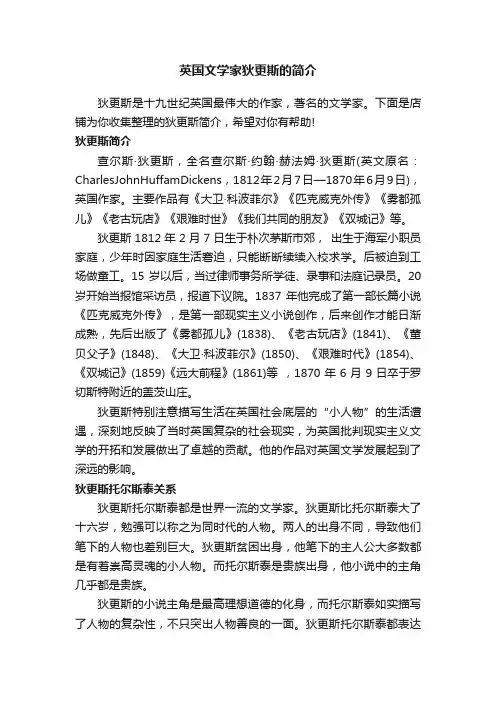
英国文学家狄更斯的简介狄更斯是十九世纪英国最伟大的作家,著名的文学家。
下面是店铺为你收集整理的狄更斯简介,希望对你有帮助!狄更斯简介查尔斯·狄更斯,全名查尔斯·约翰·赫法姆·狄更斯(英文原名:CharlesJohnHuffamDickens,1812年2月7日—1870年6月9日),英国作家。
主要作品有《大卫·科波菲尔》《匹克威克外传》《雾都孤儿》《老古玩店》《艰难时世》《我们共同的朋友》《双城记》等。
狄更斯1812年2月7日生于朴次茅斯市郊,出生于海军小职员家庭,少年时因家庭生活窘迫,只能断断续续入校求学。
后被迫到工场做童工。
15岁以后,当过律师事务所学徒、录事和法庭记录员。
20岁开始当报馆采访员,报道下议院。
1837年他完成了第一部长篇小说《匹克威克外传》,是第一部现实主义小说创作,后来创作才能日渐成熟,先后出版了《雾都孤儿》(1838)、《老古玩店》(1841)、《董贝父子》(1848)、《大卫·科波菲尔》(1850)、《艰难时代》(1854)、《双城记》(1859)《远大前程》(1861)等,1870年6月9日卒于罗切斯特附近的盖茨山庄。
狄更斯特别注意描写生活在英国社会底层的“小人物”的生活遭遇,深刻地反映了当时英国复杂的社会现实,为英国批判现实主义文学的开拓和发展做出了卓越的贡献。
他的作品对英国文学发展起到了深远的影响。
狄更斯托尔斯泰关系狄更斯托尔斯泰都是世界一流的文学家。
狄更斯比托尔斯泰大了十六岁,勉强可以称之为同时代的人物。
两人的出身不同,导致他们笔下的人物也差别巨大。
狄更斯贫困出身,他笔下的主人公大多数都是有着崇高灵魂的小人物。
而托尔斯泰是贵族出身,他小说中的主角几乎都是贵族。
狄更斯的小说主角是最高理想道德的化身,而托尔斯泰如实描写了人物的复杂性,不只突出人物善良的一面。
狄更斯托尔斯泰都表达了对底层劳动人民的深切同情。
狄更斯揭露了资本主义世界的黑暗和人民所受到的欺压。

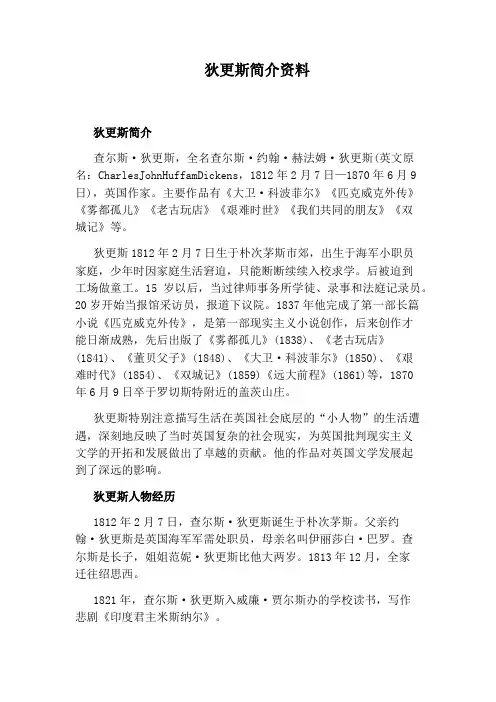
狄更斯简介资料狄更斯简介查尔斯·狄更斯,全名查尔斯·约翰·赫法姆·狄更斯(英文原名:CharlesJohnHuffamDickens,1812年2月7日—1870年6月9日),英国作家。
主要作品有《大卫·科波菲尔》《匹克威克外传》《雾都孤儿》《老古玩店》《艰难时世》《我们共同的朋友》《双城记》等。
狄更斯1812年2月7日生于朴次茅斯市郊,出生于海军小职员家庭,少年时因家庭生活窘迫,只能断断续续入校求学。
后被迫到工场做童工。
15岁以后,当过律师事务所学徒、录事和法庭记录员。
20岁开始当报馆采访员,报道下议院。
1837年他完成了第一部长篇小说《匹克威克外传》,是第一部现实主义小说创作,后来创作才能日渐成熟,先后出版了《雾都孤儿》(1838)、《老古玩店》(1841)、《董贝父子》(1848)、《大卫·科波菲尔》(1850)、《艰难时代》(1854)、《双城记》(1859)《远大前程》(1861)等,1870年6月9日卒于罗切斯特附近的盖茨山庄。
狄更斯特别注意描写生活在英国社会底层的“小人物”的生活遭遇,深刻地反映了当时英国复杂的社会现实,为英国批判现实主义文学的开拓和发展做出了卓越的贡献。
他的作品对英国文学发展起到了深远的影响。
狄更斯人物经历1812年2月7日,查尔斯·狄更斯诞生于朴次茅斯。
父亲约翰·狄更斯是英国海军军需处职员,母亲名叫伊丽莎白·巴罗。
查尔斯是长子,姐姐范妮·狄更斯比他大两岁。
1813年12月,全家迁往绍思西。
1821年,查尔斯·狄更斯入威廉·贾尔斯办的学校读书,写作悲剧《印度君主米斯纳尔》。
1824年2月20日,约翰·狄更斯因负债被捕,关在马夏尔西债务人监狱。
数周后其妻伊丽莎白及幼年子女们也迁入其中。
此前,查尔斯·狄更斯已于2月9日入华伦黑鞋油作坊当童工,因此没有随家人住进监狱,独自在朋友家借宿。
写查尔斯狄更斯的英语作文Title: Charles Dickens: A Literary Luminary of the Victorian Era。
Charles Dickens, a titan of Victorian literature, stands as a beacon of literary brilliance whose works continue to captivate and resonate with readers worldwide. Born on February 7, 1812, in Portsmouth, England, Dickens's life and literary contributions are emblematic of thesocial and economic milieu of his time. Through his masterful storytelling and acute social commentary, Dickens illuminated the injustices and inequalities rampant in Victorian society while championing the cause of the downtrodden. This essay explores the enduring legacy of Charles Dickens, highlighting his literary genius, thematic preoccupations, and lasting impact on literature.Dickens's literary oeuvre spans a wide spectrum of genres, including novels, short stories, essays, and novellas. His works, characterized by vividcharacterization, intricate plots, and poignant social critique, have secured him a permanent place in theliterary canon. Among his most renowned novels are "Oliver Twist," "David Copperfield," "Great Expectations," and "A Tale of Two Cities," each offering a panoramic view of Victorian England and its manifold contradictions. Through the lens of memorable characters such as Ebenezer Scrooge, Oliver Twist, and Pip, Dickens exposed the harsh realities of poverty, exploitation, and societal decay, while also celebrating the resilience of the human spirit.One of Dickens's most enduring legacies lies in his adept portrayal of social injustice and his unwavering advocacy for social reform. A staunch critic of the prevailing social and economic inequalities of his time, Dickens used his writing as a vehicle for social change, shedding light on the plight of the poor, the marginalized, and the oppressed. In novels such as "Hard Times" and "Bleak House," he laid bare the dehumanizing effects of industrialization, bureaucratic inefficiency, and institutionalized hypocrisy, prompting readers to confront uncomfortable truths about society's treatment of its mostvulnerable members.Moreover, Dickens's thematic concerns extend beyond mere social critique to encompass broader explorations of human nature, morality, and redemption. Central to much of his work is the motif of redemption and the possibility of personal transformation. Characters like Scrooge in "A Christmas Carol" undergo profound spiritual awakenings, moving from selfishness to generosity, from callousness to compassion. Through these narratives of redemption, Dickens imparts a message of hope and redemption, suggesting that even the most hardened hearts are capable of change and renewal.In addition to his literary achievements, Dickens's impact on the cultural and social landscape of theVictorian era cannot be overstated. His works were widely read and discussed, both in elite literary circles and among the general populace, sparking debates about social reform, moral responsibility, and the nature of humanity. Dickens's vivid depictions of Victorian life helped shape public perceptions of the era, influencing attitudes towardpoverty, class, and social justice. Furthermore, his advocacy for universal education and social welfare reforms left an indelible mark on the trajectory of social policy in Britain, contributing to the gradual amelioration of social conditions for the working class.Even today, more than a century after his death, the legacy of Charles Dickens endures, his works continuing to inspire and provoke readers around the world. Through his timeless characters and compelling narratives, Dickens invites us to confront the complexities of the human experience, to grapple with the enduring moral dilemmas of our time, and to strive for a more just and compassionate society. In an age marked by profound social upheaval and political turmoil, Dickens's voice remains as relevant and resonant as ever, reminding us of the enduring power of literature to illuminate the darkest corners of the human soul and to envision a brighter, more equitable future for all.。
Charles DickensCharles Dickens (7 February 1812 –9 June 1870) was a famous English critical realism novelist in the 19th century. “He created some of the world's most memorable fictional characters and is generally regarded as the greatest novelist of the Victorian period. During his life, his works enjoyed unprecedented fame, and by the twentieth century his literary genius was broadly acknowledged by critics and scholars.”With time going by, his novels and short stories continue to be widely popular. In his works, he paid special attention to the life of "little guy" at the bottom of society in the UK, which deeply reflected the complex social reality at that time.LIFE AND CAREERCharles Dickens was born in Portsmouth on 7 February 1812, the second son of John and Elizabeth Dickens. He had a well-off family in his early years and was once educated in a private school for a period of time, but his parents often banqueted guests and used money without restraint. As a result, his father, inspiration for the character of Mr. Micawber in David Copperfield, was imprisoned for bad debt when Charles Dickens was 10 years old. “The entire family, apart from Charles, was sent to Marshalsea along with their patriarch. Charles was sent to work in Warren's blacking factory and endured appalling conditions as well as loneliness and despair.”He worked over 10 hours every day. After three years, luckily, his father inherited a legacy of the family, so their economic conditions were improved. He was returned to school, but the experience was never forgotten and became fictionalized in two of his better-known novels David Copperfield and Great Expectations.At the age of 15, he graduated from Wellington College, and then worked into a lawyer line. Later he turned to newspaper, becoming a reporter at the age of 20.“Like many others, he began his literary career as a journalist. His own father became a reporter and Charles began with the journals The Mirror of Parliament and The True Sun. Then in 1833 he became parliamentary journalist for The Morning Chronicle. With new contacts in the press he was able to publish a series of sketches under the pseudonym 'Boz'. In April 1836, he married Catherine Hogarth, daughter of George Hogarth who edited Sketches by Boz. Within the same month, came the publication of the highly successful Pickwick Papers, and from that point on there was no looking back for Dickens.”Besides a huge list of novels, “he published autobiography, edited weekly periodicals including Household Words and All Year Round, wrote travel books and administered charitable organizations. He was also a theatre enthusiast, wrote plays and performed before Queen Victoria in 1851. His energy was inexhaustible and he spent much time abroad - for example lecturing against slavery in the United States and touring Italy with companions Augustus Egg and Wilkie Collins, a contemporary writer who inspired Dickens' final unfinished novel The Mystery of Edwin Drood.He was estranged from his wife in 1858 after the birth of their ten children, but maintained relations with his mistress, the actress Ellen Ternan.”However, too much hard work and disappointment at reform seriously impaired his health. He died of a stroke in 1870 and buried at Westminster Abbey. His tombstone wrote:“He was a sympathiser to the poor, the suffering, and the oppressed; and by his death, one of England's greatest writers is lost to the world.”MAJOR WORKSDickens wrote many works in his life, and the followings are some of his most important novels. They can be divided into different periods.From 1836 to 1841, it was the first period of youthful optimism. The major works are Sketches by Boz, The Pickwick Papers, Oliver Twist, Nichols Nickleby, The Old Curiosity Shop and so on. “Pickwick Papers (1836-37) was D ickens’ first big popular success, written when he was only twenty-four years old. It was issued in twenty monthly parts and is not so much a novel as a series of loosely linked sketches and changing characters featured in reports to the Pickwick Club. These episodes narrate comic excursions to Rochester, Dingley Dell, and Bath; duels and elopements; Christmas festivities; Mr Pickwick inadvertently entering the bedroom of a middle-aged lady at night; and in the end a happy marriage. Much light-hearted fun and a host of memorable characters are filled in this work. Oliver Twist(1837-38) expresses Dickens’ sense of the vulnerability of children. Oliver is a foundling, raised in a workhouse, who escapes suffering by running off to London. There he falls into the hands of a gang of thieves controlled by the infamous Fagin. He is pursued by the sinister figure of Monks who has secret information about him. The plot centres on the twin issues of personal identity and a secret inheritance (which surface again in Great Expectations). Emigration, prison, and violent death punctuate a cascade of dramatic events. This is the early Victorian novel in fine melodramatic form. It is recommended for beginners to Dickens.”The second period of excitement and irritation expose the corrupting influence of wealth and power, optimism turned into dissatisfaction andirritation.David Copperfield(1849-50) is a thinly veiled autobiography, of which Dickens said ‘Of all my books, I like this the best’. As a child David suffers the loss of both his father and mother. He endures bullying at school and a life of poverty when he goes to work. he soon runs away to his Aunt Betsey Trotwood in Dover. Aunt Betsey adopts him and sends him to Dr. Strong's private school in Canterbury, where David meets his best friend Agnes Wickfield, as well as the slimy Uriah Heep.David grew up and became a lawyer, he fall in love with beautiful but childish Dora Spenlow. He marries Dora, despite her uselessness in household chores. However, Dora Spenlow soon falls ill and dies, leaving David single and heartbroken. David is very sad, and left his country. He travels throughout Europe, during which time he publishes his first novel with the help of old school-friend Thomas Traddles, and during this odyssey realizes he loves Agnes Wickfield. Upon his return he proposes to her, and the two quickly marry. They later move into a house in London along with their young children. The book is packed with memorable characters such as Mr. Micawber, the fawning Uriah Heep, and the earth-mother figure Clara Peggotty. The plot involves Dickens’ recurrent topics of thwarted romance, financial insecurity and misdoings, and the terrible force of the legal system which haunted him all his life.The third period of intensifying (increasing) pessimism, showed underlying tone of bitterness, loss of hope for English bourgeois society.“A Tale of Two Cities(1859) was Dickens’ account of the French Revolution –with the story switching between London and Paris. It views the causes and effects of the Revolution from an essentially private point of view, showing how personal experience relates to public history. The characters are fictional, and their political activity is minimal, yetall are drawn towards the Paris of the Terror, and all become caught up in its web of suffering and human sacrifice. The novel features the famous scene in which wastrel barrister Sydney Carton redeems himself by smuggling the hero out of prison and taking his place on the scaffold.”The novel ends with the memorable lines: "It is a far, far better thing that I do, than I have ever done; it is a far, far better rest that I go to, than I have ever known." Great Expectations (1860-61) traces the adventures and moral development of the young hero Pip as he rises from humble beginnings in a village blacksmith’s. Eventually, via good connections and a secret benefactor, he becomes a gentleman in fashionable London –but loses his way morally in the process and disowns his family. Fortunately he is surrounded by good and loyal friends who help him to redeem himself. Plenty of drama is provided by a spectacular fire, a strange quasi-sexual attack, and the chase of an escaped convict on the river Thames. There are a number of strange psycho-sexual features to the characters and events, and the novel has two subtly different endings –both adding ambiguity to the love interest between Pip and the beautiful Stella. There are other famous works in this period, such as Bleak House(1852-1853), Hard Times(1854) and so on.STYLESHe has different writing styles in different periods. In his early period, the works are of gentle social criticism, Fantastic optimism, La novela picaresca and Exaggeration. In his middle period, the works are of vigorously criticizing on bourgeois and his morality, gentle moralism, humor and satire. At the same time, The plot and structure are more complete and unified. In his later period, the works are of socialcriticism, gentle reformism and strong humanitarian, exploration of man’s inner confli cts and symbolismHis literary style is also a mixture of fantasy and realism. “Dickens was once a newspaper reporter so his descriptions show a wonderful eye for detail. Dickens loved words, and liked to produce a 'pretty piece of writing' in different styles. He included lots of powerful adjectives, and is famous for his use of metaphors and similes. His descriptions often present people, their surroundings, and even the weather, in ways which reinforce each other, so that certain 'feel' is built up through the passage. From the early 1850s, Dickens gave public readings of his novels. His writing is rhythmic and designed to be read out loud. He loved to make young women in his audience laugh or weep, so many of his characters are either hilariously comic or heart-broken sentimental. In addition, Dickens was also a master of dialect and used what is called 'substandard' speech to add to the picture of a character he was building up.”References1.《插图本英国文学史》2.。
小说家狄更斯的简介查尔斯狄更斯是十九世纪英国最伟大的作家,作品揭露了社会的黑暗,赞扬了惩恶扬善的精神。
查尔斯狄更斯早年家境小康,曾经在私立学校接受过教育。
下面是店铺搜集整理的小说家狄更斯的简介,希望对你有帮助。
小说家狄更斯的简介查尔斯·狄更斯(Charles Dickens,1812--1870)是英国十九世纪伟大的批判现实主义作家,一生创作了大量作品,广泛描写了19世纪英国维多利亚时代的社会生活,揭露了资产阶级金钱世界的种种罪恶。
狄更斯(1812-----1870)英国现实主义作家,是继莎士比亚之后对实界文学产生巨大影响的小说家。
代表有《匹克威克外传》《双城记》《大卫·科波菲尔》等。
狄更斯所生活的年代,英国资本主义经济发展迅速。
经济繁荣的同时,现实的阶级矛盾也逐渐加深统治阶级疯狂追求利润,想发横财,工人们失业无家可归。
狄更斯从人道主义出发,呼吁统治者在追求个人利益的同时,不能剥夺劳动人民的权力,劝戒统治者要讲道德,有良知得人。
小说家狄更斯的生平1812年2月7日,狄更斯出生在英国南部朴次茅斯的波特西地区一个贫寒的小职员家庭里。
父亲是海军会计处的小职员,因无法清偿债务而被投进债务监狱。
这时刚满10岁的狄更斯不得不挑起全家生活重担,11岁时就被送到一家皮鞋油作坊去当童工。
为节省开支,母亲和弟妹都搬进监狱和父亲住在一起。
狄更斯在外做工,每逢星期日领到薪水就买些食物去监狱看望父母弟妹。
后来狄更斯的父亲继承了一位远亲的一笔遗产,还清债务后出狱。
狄更斯离开鞋油作坊进入一家小学读书,对学校里摧残儿童的野蛮教育十分反感。
狄更斯充满痛苦的童年生活,使他一生对穷人,特别是对贫苦儿童怀着深切同情,后来写了不少儿童题材的作品,如《大卫·科波菲尔》中就有他童年生活的影子。
由于家庭贫穷,狄更斯从16岁开始,先后做过律师的抄写员、事务所的信差、法院的速记员,这使他走遍伦敦的大街小巷,出入法院和监狱,接触到各种人物,了解到各种诉讼案件。